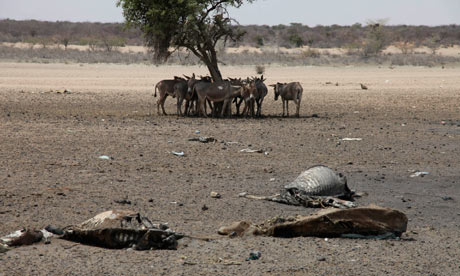Environmentalists call for the development of early warning systems to help countries prepare for adverse weather

Carcasses of cattle lie on the ground near Lagbogal, Kenya, earlier this week. Scientists are blaming La Niña for the drought, which is the worst seen in the Horn of Africa for more than 60 years. Photograph: Sayyid Azim/AP
As parts of the Horn of Africa experience their driest periods in 60 years, pushing the numbers needing aid to beyond 10 million, some have been quick to blame climate change.
But no single event can be attributed to climate change, which involves long-term (decades or longer) trends in climate variability. There is, however, consensus in attributing the drought to the particularly strong La Niña event. The impact of climate change on the intensity and frequency of La Niña and El Niño in future is unknown.
IRIN spoke to two experts, an environmentalist and a scientist, who have worked extensively in the region.
Philip Thornton, a senior scientist who works part-time with the Nairobi-based International Livestock Research Institute (ILRI) and the University of Edinburgh-based Institute of Atmospheric and Environmental Sciences, has done some pioneering work on projections of climate-change impact in eastern and southern Africa.
He told IRIN via email that projections of the climate change impact in east Africa were "a problem" as the authoritative inter-governmental panel on climate change's (the IPCC) fourth assessment report "indicated that there was good consensus among the climate models that rainfall was likely to increase during the current century.
"But work by other climate scientists since then suggests that ... certain Indian Ocean effects in east Africa may not actually occur.
"Some people think that east Africa is drying, and has dried over recent years; currently there is no hard, general evidence of this, and it is very difficult as yet to see where the statistical trends of rainfall in the region are heading, but these will of course become apparent in time."
The IPCC's fifth assessment report will be released in 2014.
Jan de Leeuw is the operating project leader in the vulnerability and sustainability in pastoral and agro-pastoral systems within ILRI's people, livestock and environment theme. He points out that this La Niña event is one of the strongest since the 1970s. But he says La Niña, along with El Niño, appear in cycles that "we don't understand".
What we do know is that La Niña started to develop in August 2010. It cools surface waters in the central and eastern Pacific Ocean, while allowing warmer water to build in the eastern Pacific. "The pool of warm water in the east intensifies rains in Australia, the Philippines, and Indonesia. Domino-style, this pattern also increases the intensity of westerly winds over the Indian Ocean, pulling moisture away from east Africa toward Indonesia and Australia. The result? Drought over most of east Africa and floods and lush vegetation in Australia and other parts of Southeast Asia," according to the US government's National Aeronautics and Space Administration.
De Leeuw writes: "La Niña events were common from 1950 till 1976. Since then we had two decades [until about 1996] with fewer events of lesser depth. This has changed since then and over the last 15 years or so we have had more frequent La Niña events."
Events as deep as the current La Niña occur once in 20 or 30 years, writes De Leeuw. "We are in a period now of more frequent La Niña events, but such a situation was there from 1950 till 1976 also."
Thornton has the last word when he says research attention must focus on developing effective early warning systems and ways to help people affected by these events, who have no use for "academic" consideration of the linkages with climate change to cope better with the current levels of weather variability, "whatever happens in the future".
http://www.guardian.co.uk/global-development/2011/jul/14/east-africa-drought-la-nina











No comments:
Post a Comment